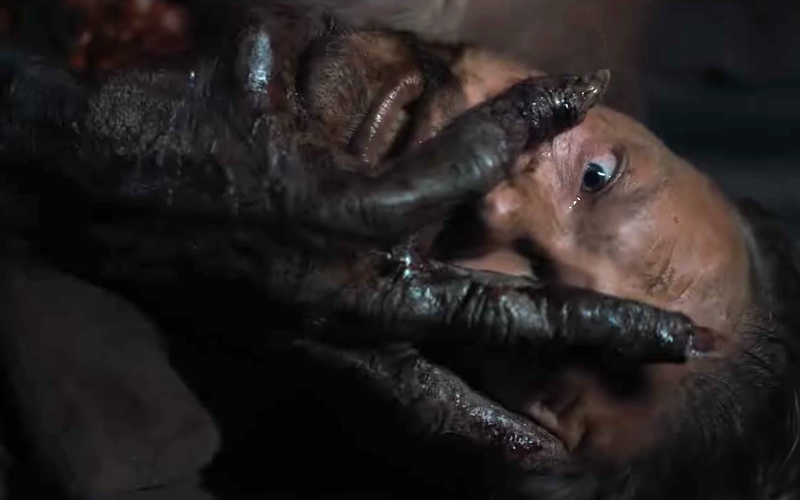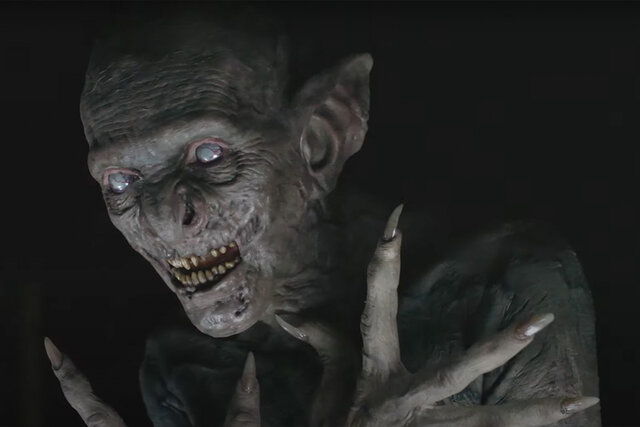by Mike Lera
Like “Superman”, Dracula is one of those iconic, enduring characters who just can’t help get repeated over and over throughout cinematic history. From classic Bela Lugosi to BBC’s Claes Bang, hardly a decade goes by without some sort of new take or spin or turn on the famous/infamous vampire of vampires, be it horror or comedy. With all the countless Counts we’ve seen since his introduction in Bram Stoker’s 1897 novel and first screen adaptation in Nosferatu (1922), you’d think we’d be tired of this gothic caped creature by now.
Hardly.
There’s something about new Dracula stories we enjoy, especially those with a fresh twist such as the recently released horror film The Last Voyage of the Demeter, and considering the incredibly large shoes (and fangs) it was given to fill, one word sums up this latest narrative of the blood sucking Transylvanian: Ambitious.
For those unfamiliar with the famous story who may be quick to mutter, “Titanic Meets Dracula” or “Vampire On A Ship”, it’s important to note that Demeter is a “cross” section (no pun intended) from a chapter amid the lengthy, 500-page book. While many past Dracula films started and stopped where the Stoker novel begins and ends, Demeter is a clever “zoom in” on one of the darker, scarier and yet shorter parts of the book.
Just as 1992’s successful Bram Stoker’s Dracula entailed various scenes of “journal” and “letter” entries from which the novel was completely comprised of, Demeter uses the same unique motif in the form of a ledger, keeping to the book’s section “Log Of The Demeter” within Chapter 7, composed of just a few pages of an account book from a ship captain, dating from July 6th to August 4th. The film opens in the year 1897 with a crew of Romanians boarding a large Russian cargo ship, The Demeter, in Varana, Bulgaria, destined for England. One of the men spots a mysterious emblem engraved on a rectangular wooden “box”, the superstitious sailor suspecting that the schooner is destined for something else. Shortly after the ship sets sail on the Aegean sea, an assortment of animals within the ship’s basement are found mutilated. Later, our protagonist Clemens, a medical doctor played by Corey Hawkins (Straight Outa Compton, Kong: Skull Island), discovers a woman named Anna, a “stowaway” on the verge of death and in desperate need of a blood transfusion, viciously bitten on her neck by something. When Anna is finally conscious, she utters the words, “He’s here”, and the real terror begins. One by one, each crew member meets a bloody and horrific fate at the hands of a gruesome, ghastly “thing” roaming hungrily about the ship. A beast that’s neither animal… nor human!
Off the “bat” (pun intended), this snapshot idea for Stoker’s epic is conceptually brilliant, given that legions of Dracula fans have often pondered over detailed events within the chambers and bowels of the Demeter between Romania and England, outside of the captain’s log. In addition, an amazing set design, beautiful cinematography and excellent score help set the movie’s cold, grim tone and atmosphere.


Overall, however, Demeter suffers from a formulaic and predictable storyline, filled with all the standard and familiar “frights” that big-budgeted horror movies tend to shovel out, and while director Andre Ovredal does a phenomenal job at presenting an intense, consistent “face your fears” theme throughout the piece, the script comes across as weak and trite, lacking originality and substance. Since there wasn’t much description on specific persons in the novel’s “log” chapter, Demeter creates its own characters, however, most of them are flat and vague. The character of Anna, for instance, offers a nice layer of intrigue, yet is without any real depth and seems to be there solely as an attempt to make the story more interesting and alluring. Plenty of blood and gore for sure, and yet the film falters in bringing any serious terror or “jump scares”, considered crucial for a Dracula story. To note, the appearance of Demeter’s Dracula takes on his more “beastly” look for the entire movie, a blend of Kurt Barlow and a taller Balrog and an homage to Nosferatu’s “Orlok”, which may disappoint some fans who prefer the “variation” of the Count’s face/figure depicted in such films as Bram Stoker’s Dracula. But even those who see Demeter as an unofficial Nosferatu “remake” may find themselves wanting a more different “creepy-creature” effect rather than the all too familiar Max Schreck image.
To be fair, creating a horror story taking place in limited quarters such as a ship is hard to pull off – they can either go good (a la Alien), or not so good. Demeter, unfortunately, assumes the latter, filled with scenes that become redundant and uninteresting, slowly sailing off into a dry and dreary voyage.
Again, The Last Voyage of the Demeter is an ambitious piece of work, taking on a character whose legacy has lasted for well over a century, and though it captures the mood and ambience of a traditional Dracula tale and offers some shocking scenes, Demeter misses the mark in delivering the scares and storyline needed to help bring an awesome concept to shore.
Grade: C-

